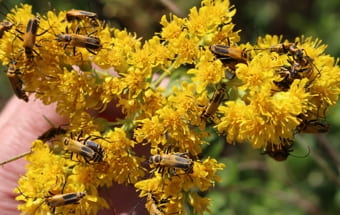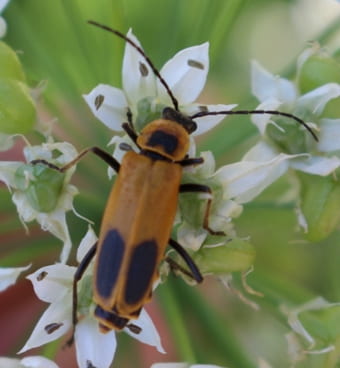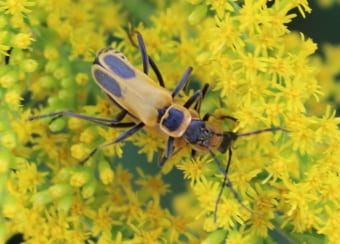–by Cassandra Olds, Livestock and Veterinary Entomology
Horse owners may be noticing the appearance of small yellow eggs laid on the legs of their horses. All four legs can be targeted but higher egg numbers are normally observed on the front legs (Figure 1). These eggs are laid by the horse bot fly, Gasterophilus intestinalis (DeGeer) with each female laying between 150 and 1000 eggs! Eggs are glued to the hair shaft and multiple eggs can be laid on a single hair strand (Figure 2).

Figure 1: Horse bot fly eggs laid in batches attached to hair on the hind (A) and front (B and C) legs of a horse. This horse had well over 700 eggs in total.

Figure 2: Removed horse bot fly eggs still attached to horse hair. Multiple eggs can be laid on a single hair strand. These eggs were removed prior to hatching as the egg casing remains intact and closed.
Eggs hatch within 10 days, stimulated by horse licking and increased humidity. Larvae enter the horse mouth and imbed in the tissue where they remain for roughly 28 days. After molting, second stage larvae exit mouth tissues and are swallowed, thereby moving the stomach. The larva can remain in the stomach for 9-12 months where it molts into the third and final larval stage. After maturing the third instar detaches from the digestive tract and is passed out in the feces. The larva will burrow into the soil and pupate where it will remain for 1-2 months. As horses tend to create manure piles, the number of flies pupating in an area can become significant. Adult flies can cause significant fly worry, adverse reactions to flies can result in horses injuring themselves trying to escape from attack. Under high numbers, reduced grazing can result in weight loss. Significant mouth irritation can occur when first instar larvae burrow into oral tissue and although horses can tolerate low levels of stomach parasitism, large numbers can cause blockages, colic and reduced nutrient uptake.
Control can be achieved through a combination of sanitation, egg removal and correctly timed oral dewormer. Removing eggs immediately will significantly reduce the risk of a horse consuming larvae and initiating the infestation cycle. A simple and inexpensive ($3-7) bot egg knife (Figure 3) can be used to physically remove eggs from the legs.

Figure 3: A bot fly knife can be used to remove bot fly eggs from horse hair by scraping downwards with the direction of hair growth.
Deworming one month after eggs were noticed will kill any second instar larvae that may have been consumed and now reside in the stomach. A second round of dewormer can be administered 6 months after the first dose to remove any third instar larvae. Removing manure piles from the site can reduce the number of adult flies emerging.








